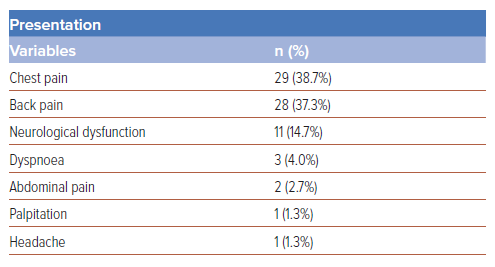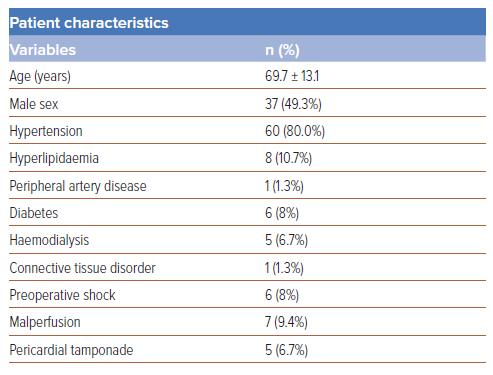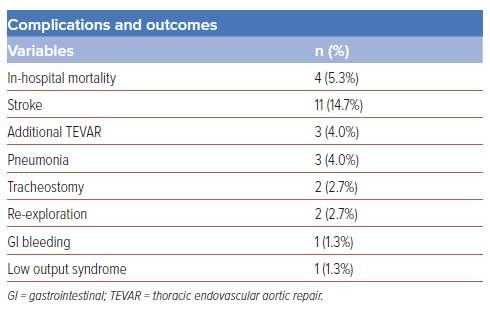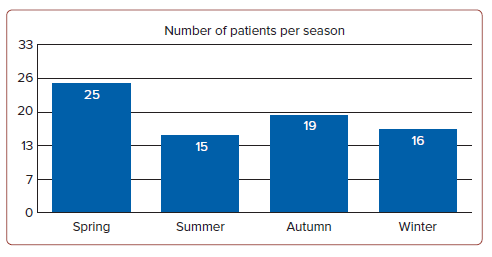Stanford type A acute aortic dissection (TAAD) is a critical presentation for emergent surgery performed by cardiovascular surgeons. The result of emergent operations for TAAD has improved tremendously.1 The International Registry of Acute Aortic Dissection reported a 17-year trend in 2015. In this report, most patients presenting with TAAD were managed surgically (86% overall), with a significant increase in operative procedures later in the study period (79–90%). Additionally, given the advancements in surgical technique, perioperative care and devices, type A in-hospital all-cause mortality decreased significantly (31–22%; p<0.001), as did surgical mortality (25–18%; p<0.003).
The Japanese Registry of Acute Aortic Dissection reported the Japanese surgical outcomes for TAAD in 2020.2 A total of 916 patients received surgical intervention between 2011 and 2016, with an in-hospital mortality rate of 11.6%. Recent reports have shown a reduction in mortality. Ogino et al. reported on patients who received surgical treatment in 2021, demonstrating a rate of in-hospital mortality of <10% (9.8%).3 Epidemiological data reported previously have demonstrated an incidence rate of TAAD ranging from 2.5 to 7.2 per 100,000 person-years in several population-based registries in western countries.4–8 However, reports on the epidemiology of TAAD from Asian countries are scarce.
The relationship between cold temperature and the occurrence of TAAD has been reported by several authors. Zhang et al. reported that low temperature and decline in temperature increase the TAAD risk.9 Mehta et al. reported that the peak TAAD occurrence was observed in winter.10
Sapporo has a population of approximately 2 million people, and experiences heavy snowfall of approximately 4 m each winter.11 Its unique aspect is its dense population during heavy winter conditions. Typically, areas affected by heavy winter are sparsely or temporarily populated; therefore, clinical data from such regions are limited.
The purpose of this study was to investigate the epidemiology and outcome of TAAD surgery in a single urban hospital located in Sapporo, Hokkaido, in the northeast of Japan, and to analyse the seasonal differences, especially in winter.
Methods
Between June 2017 and July 2023, 75 patients with TAAD who received emergent operations were included in this study. All diagnoses were confirmed using contrast CT. The Stanford classification of aortic dissection was used to categorise the disease according to its location. Our treatment strategy for TAAD was to basically perform an emergent operation to achieve resection of the primary tear. Cases with thrombosed false lumens and an ascending aorta diameter <45 mm; those with an ascending aorta false lumen thickness <10 mm; and those without any complications received medical treatment.12
The Institutional Review Board of Sapporo Kojinkai Memorial Hospital approved this study and waived the requirement for individual consent owing to the retrospective nature of the study. The seasons were defined as follows: spring, March to May; summer, June to August; autumn, September to November; and winter, December to February.
Surgical Strategy
The basic surgical strategy was to resect the primary entry tear. If the primary entry tear was located on the ascending aorta, then we performed ascending aortic replacement, and if it was located on the arch, then we performed total or partial arch replacement. However, if the patient was relatively young and there was a future possibility of arch dilatation, then we performed total arch replacement at the surgeon’s discretion, even if the entry tear was located on the ascending aorta.
The operation was conducted under moderate hypothermia (25°C) with selective antegrade cerebral perfusion, no aortic clamp and arch first reconstruction where necessary. All operations were performed with open-distal anastomosis.
Characteristics of Sapporo City
Sapporo is the capital city of Hokkaido Province in the northeast of Japan, and has a population of approximately 2 million people. The city is famous for heavy snow, at approximately 4 m per winter. In 2023, the average temperature was 10.2°C, the lowest temperature was −10.4°C and the highest temperature was 32.9°C.
Patient and Public Involvement Statement
Neither the patients nor members of the public were involved in the design, conduct, assessment, reporting or dissemination of this paper.
Results
Overall Analysis
Presenting Complaints
The presenting complaints are summarised in Table 1. Among the included patients, 29 (38.7%) complained of chest pain, 28 (37.3%) complained of back pain and 11 (14.7%) exhibited neurological dysfunction. Neurological dysfunction included the following: syncope (4; 5.3%), paralysis (3; 4.0%), hemiplegia (1; 1.3%), dysphagia (1; 1.3%), drowsiness (1; 1.3%) and seizure (1; 1.3%). Dyspnoea was seen in three patients (4.0%), abdominal pain was present in two (2.7%), and palpitation and headache were seen in one patient each (1.3%).
Patient Characteristics
The patients’ baseline clinical characteristics are summarised in Table 2. The mean age of the patients was 69.7 ± 13.1 years, and 37 (49.3%) were men. A total of 60 (80%) and eight (10.7%) had hypertension and hyperlipidaemia, respectively. One (1.3%) patient each had peripheral artery disease and connective tissue disorder. Six (8.0%) patients arrived in cardiogenic shock on admission, seven patients (9.4%) showed preoperative malperfusion and five (6.7%) patients demonstrated tamponade.
Operative Outcomes
The operative outcomes are summarised in Table 3 and Supplementary Table 1. Ascending aortic replacement was performed in 37 patients (49.3%). In the remaining 38 cases, total arch replacement was performed in 34 cases, whereas four cases received partial arch replacement. The additional procedures were as follows: aortic valve reimplantation (n=1), coronary artery bypass grafting (n=3), aortic valve replacement (n=2), open stent grafting (n=5), closure of patent fossa ovalis (n=2) and pulmonary artery embolectomy (n=1). The in-hospital mortality rate was 5.3% (n=4). Stroke occurred in 11 cases (14.7%), additional thoracic endovascular aortic repair for malperfusion of the lower body was performed in three (4.0%), pneumonia was reported in three (4.0%), tracheostomy was performed in two (2.7%), re-exploration for bleeding was performed in two (2.7%) and gastrointestinal bleeding was observed in one (1.3%).
Disease Seasonality
The disease seasonality is summarised in Figure 1. A total of 25 (33.3%), 15 (20.0%), 19 (25.3%) and 16 (21.3%) patients had TAAD in spring, summer, autumn and winter, respectively, with no significant difference in the occurrence between groups.
Analysis Between Winter and Other Seasons
The results of the analysis of patient characteristics, presentation and surgical outcomes between winter and other seasons (i.e. spring, summer and autumn) are summarised in Table 4. In winter, the patients who had TAAD were significantly older than those in other seasons (winter: 78.9 ± 3.1 years; other seasons: 67.3 ± 1.6 years; p=0.0013). Additionally, a higher proportion of women tended to have TAAD in winter. The other characteristics and surgical outcomes were not significantly different between winter and other seasons.
Discussion
The surgical outcomes of TAAD have significantly improved in recent years. Indeed, recent reports revealed a reduction in mortality from 33% in 1998 to 9.8% in 2021. As a result of this improvement, many researchers have sought to analyse the demographic differences between patient presentations and the surgical outcome. However, most research has been reported by European countries and the US, whereas reports from Asian countries remain scarce.
Here, we report the seasonal differences, presentation, characteristics and early outcomes of patients who received emergent surgery for TAAD in Sapporo. We also analysed the difference in patient characteristics, presentation and surgical outcomes between winter and other seasons.
Sapporo city has unique characteristics due to its dense population during heavy winter conditions. Sapporo’s climate is characterised by deep snow and four clearly distinguished seasons: spring, summer, autumn and winter. Consequently, the inhabitants are subjected to wide variations in temperature, with the highest and lowest temperatures in 2023 being 36.3 and −13.2°C, respectively. Several researchers, including a group in China, have reported the relationship between low temperature and the occurrence of TAAD, with a higher occurrence rate reported in winter. Our results show that the onset of TAAD showed no significant difference between seasons. However, more older people, predominantly women, had TAAD in winter.
In the current study, the overall surgical results were similar to those reported by the International Registry of Acute Aortic Dissection and Japanese Registry of Acute Aortic Dissection registries.1,2 The study provides valuable epidemiological insights into TAAD occurrence and outcomes in a specific urban setting, Sapporo, Japan. This offers a unique perspective on the disease in a population characterised by distinct seasonal variations and environmental factors, such as heavy snowfall at low temperatures. The study focused on surgical outcomes following emergent operations for TAAD, providing important information on procedural success rates, complications and in-hospital mortality. This contributes to the literature on TAAD management, and helps guide clinical decision-making.
Study Limitations
This study had some limitations. One limitation was the small cohort size. Another limitation was the variability in surgical strategies employed, which was left to the discretion of individual surgeons.
Conclusion
Older patients showed a greater tendency to have TAAD in winter than in other seasons in a Sapporo urban hospital. The surgical outcome of TAAD at our hospital was better than national reports (hospital mortality: 5.3%; national report: 9.8%). However, to comprehensively understand the impact of the winter season on TAAD occurrence and outcomes in Sapporo, large-scale multicentre analyses are warranted, providing deeper insights into the seasonal dynamics of TAAD to inform targeted interventions, and optimise patient care and outcomes.
Clinical Perspective
- Healthcare providers should be aware of the increased propensity for older female patients to experience Stanford type A acute aortic dissection (TAAD) during winter, particularly in regions with distinct seasonal variations, such as Sapporo.
- Vigilance during winter can facilitate timely diagnosis and intervention, potentially improving patient outcomes.
- Clinicians should consider the seasonal dynamics of TAAD occurrence when managing patients, especially during winter; this may involve closer monitoring of at-risk populations and proactive interventions to mitigate risk factors associated with seasonal fluctuations, such as cardiovascular health promotion strategies.
- Our study highlights the importance of specialised care in achieving favourable surgical outcomes for TAAD.
- Healthcare institutions should ensure access to specialised expertise and treatment protocols to optimise patient outcomes and reduce mortality.
- The findings of this study can be used to develop targeted interventions to reduce the burden of TAAD, which may include public awareness campaigns, education initiatives and resource allocation strategies to address seasonal variations in TAAD occurrence.
- Further research is needed to explore potential mechanisms underlying seasonal variations in TAAD.















